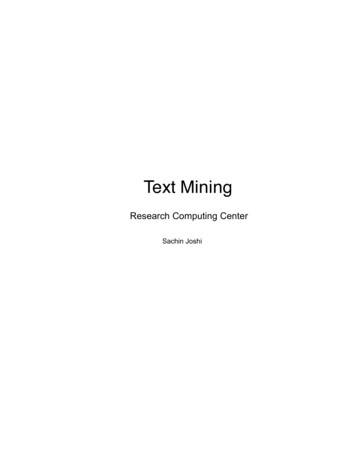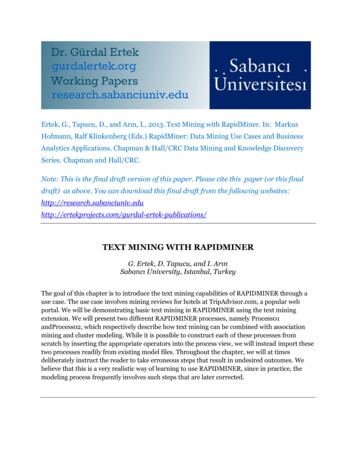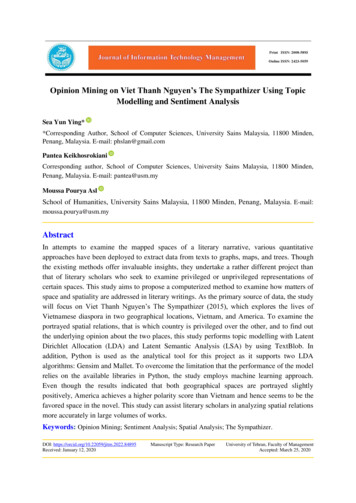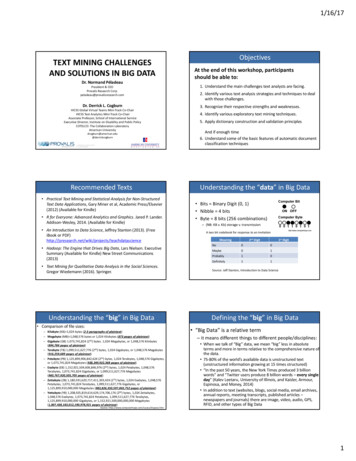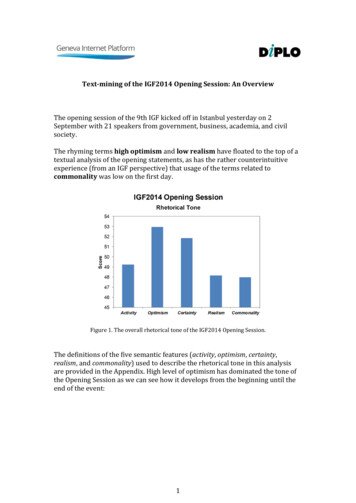
Transcription
Text-mining of the IGF2014 Opening Session: An OverviewThe opening session of the 9th IGF kicked off in Istanbul yesterday on 2September with 21 speakers from government, business, academia, and civilsociety.The rhyming terms high optimism and low realism have floated to the top of atextual analysis of the opening statements, as has the rather counterintuitiveexperience (from an IGF perspective) that usage of the terms related tocommonality was low on the first day.Figure 1. The overall rhetorical tone of the IGF2014 Opening Session.The definitions of the five semantic features (activity, optimism, certainty,realism, and commonality) used to describe the rhetorical tone in this analysisare provided in the Appendix. High level of optimism has dominated the tone ofthe Opening Session as we can see how it develops from the beginning until theend of the event:1
Figure 2. The rhetorical tone of the IGF2014 Opening Session as itdeveloped during the eventIn the prefix competition, one that had almost disappeared from IG language, reemerged this year due to NETmundial. Net is ahead of those traditionally leadingprefixes ‒ e-, cyber, and digital. Another notable change, in addition to Net’s reemergence, is the move from e- to digital. E- was the main prefix in the early2000s and during the WSIS process, when it described e-commerce, e-health,and other WSIS follow-ups. One of the main explanations of this evolution frome- to digital is a switch in the EU’s lingo. In the early 2000s, the EU’s LisbonAgenda was an e-agenda. The EU switched to digital partially to signal a newstart to its digital policy and to distance itself from the mixed results of theLisbon agenda.Figure 3. Frequency (per 1000 words) of selected IG words.2
“Internet”, “Internet Governance”, and “multistakeholder” were frequently used inthe Opening Session. Figure 4a provides an overview of word frequency for 30most frequently used word, while the word cloud in Figure 4b encompassesmany more.Figure 4a. Thirty most frequently used words and phrases in the IGF2014Opening Session.Figure 4b. IGF2014 Opening Session word cloud.3
The distributions of word usage across the speeches delivered during the sessionwere used to extract the most significant associations between the 15 mostfrequently used words and phrases:Figure 5a. Associations between the 15 most frequently used words andphrases. The usage of “Internet” was highly correlated with the usage of“people” across the speeches delivered during the IGF2014 OpeningSession.Figure 5b. Top associations for “internet”.4
The following semantic space, representing the similarity of the 21 mostfrequently used words and phrases, was produced by examining the sentencelevel co-occurrences:Figure 6. The semantic space of the IGF2014 Opening Session. The distancesbetween words represented similarity: the closer the two words stand inthe semantic space, the more similar was the context of their usage.5
AppendixDiction 6 was used to produce the scores for rhetorical tone analyses (Figure 1 and 2)according to five semantic features: certainty, optimism, activity, realism, andcommonality. These five semantic features are defined as following:Certainty: language indicating resoluteness, inflexibility, and completeness and atendency to speak ex cathedra.Optimism: Language endorsing some person, group, concept or event, or highlightingtheir positive entailments.Activity: Language featuring movement, change, the implementation of ideas and theavoidance of inertia.Realism: Language describing tangible, immediate, recognizable matters that affectpeople's everyday lives.Commonality: language highlighting the agreed-upon values of a group and rejectingidiosyncratic modes of engagement.Diction software is widely used in the analyses of rhetorical tone. The introduction tothe principles upon which it is based in found in:R. P. Hart, "Systematic Analysis of Political Discourse: The Development of DICTION", in K.Sanders, et al. (Eds.), Political Communication Yearbook: 1984 (Carbondale, IL: SouthernIllinois University Press, 1985), pp. 97-134.Text mining procedures used to produce figures 3 – 5 were developed in R, using andextending the functionality of the tm() package.The R Project for Statistical Computinghttp://www.r-project.org/tm: Text Mining ndex.htmlFeinerer, I., Hornik, H. & Meyer, D. (2008). Text Mining Infrastructure in R. Journal ofStatistical Software, Vol. 25, Issue 5, Mar c spaces (Figure 6) were obtained from the multidimensional scaling (smacoff()in R was used) of the term co-occurrence matrix previously produced in the KNIMEdata-mining platform. Figure 6 presents the 3D subspace from a 4D solution that hasachieved a satisfying level of stress.KNIMEhttps://www.knime.org/KNIME Text singThiel, K. & Berthold, M. (2012). The KNIME text processing feature: An Introduction.Technical Report.https://tech.knime.org/files/knime text processing introduction technical report 120515.pdf6
SMACOF: multidimensional scaling in ex.htmlJ. De Leeuw and P. Mair. Multidimensional Scaling Using Majorization: SMACOF in R.Journal of Statistical Software, 31(3):1-30, ical analysis and R programming:Goran S. Milovanović, PhDDiploFoundation, BelgradeTwitter: @GSMilovanovic7
Text-mining of the IGF2014 Opening Session: An Overview . The opening session of the 9th IGF kicked off in Istanbul yesterday on 2 September with 21 speakers from government, business, academia, and civil society. The rhyming terms high optimism and low realism have floated to the top of a




